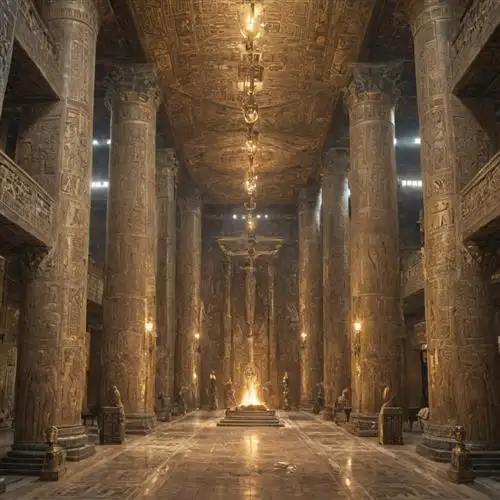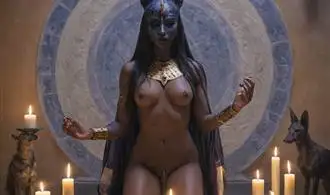
Anubis The Gatekeeper of the Afterlife
Anubis, the jackal-headed deity of ancient Egyptian mythology, is a figure of profound significance in the realm of the afterlife. As the Gatekeeper of the Afterlife, Anubis played a crucial role in guiding the souls of the deceased through the intricate and often perilous journey to the hereafter. His role was pivotal in ensuring the safe passage of the dead, as well as overseeing the meticulous process of mummification and the preservation of the physical body.
Anubis was believed to preside over the weighing of the heart ceremony, a critical moment in the journey of the soul. During this ritual, the deceased's heart was weighed against the feather of Ma'at, the goddess of truth and justice. If the heart was found to be pure and free of sin, the soul was granted passage to the afterlife. Anubis, with his keen eyes and unwavering judgment, played the role of the impartial overseer, ensuring the integrity of this sacred process.
Beyond his duties as the Gatekeeper, Anubis was also revered as a protector of the dead. He was responsible for guarding the tombs and the mummified remains, ensuring the safety and preservation of the departed. This aspect of Anubis's persona was particularly significant, as the ancient Egyptians placed great emphasis on the sanctity of the afterlife and the importance of honoring the dead.
Interestingly, the symbolic significance of Anubis extended beyond the realm of the afterlife. The jackal-headed deity was also associated with the process of embalming and mummification, as the ancient Egyptians believed that Anubis himself had taught them the art of preserving the physical body. The intricate rituals and techniques employed in mummification were seen as a means of ensuring the continuity of life after death, with Anubis as the guiding force behind this sacred practice.
The Scales of Judgment in the Afterlife
In the ancient Egyptian faith, the Scales of Judgment played a central role in the afterlife. These scales, presided over by the jackal-headed god Anubis, were used to weigh the deceased's heart against the feather of Ma'at, the goddess of truth and justice. This ritual, known as the "Weighing of the Heart," determined the fate of the soul in the afterlife.
The process was believed to be a critical step in the journey to the afterworld. The deceased's heart, representing their deeds and character, was placed on one side of the scales, while the feather of Ma'at, symbolizing truth and balance, was placed on the other. If the heart was found to be heavier than the feather, it was deemed impure and the soul was condemned to be devoured by the monstrous creature Ammit, a being with the head of a crocodile, the torso of a lion, and the hindquarters of a hippopotamus.
However, if the heart was found to be in balance with the feather of Ma'at, the soul was deemed worthy and allowed to pass on to the afterlife, where they would join the company of the gods and the blessed dead. This process was seen as a means of ensuring that only those who had lived a virtuous and truthful life were granted access to the eternal realm.
The Scales of Judgment were not only a symbol of the afterlife but also a reflection of the ancient Egyptian belief in the importance of maintaining a balanced and righteous existence. The weighing of the heart was seen as a final test, a last opportunity for the deceased to account for their actions and be judged accordingly.
The Transformation of the Soul in the Afterlife
According to ancient Egyptian beliefs, the journey of the soul after death was a transformative process, guided by the enigmatic god Anubis. As the patron deity of the afterlife, Anubis played a crucial role in the transition from mortal life to the eternal realm. This transformation of the soul was a complex and multifaceted experience, shaped by the individual's actions and beliefs during their earthly existence.
At the heart of this process was the concept of the ka, the spiritual double or essence of the individual. The ka was believed to continue to exist after death, and it was Anubis's responsibility to ensure its safe passage to the afterlife. The soul's journey was a delicate balance between the physical and the spiritual, as the ka sought to be reunited with the ba, the part of the soul that represented the individual's personality and consciousness.
The transformation of the soul was not a simple or straightforward process. It involved a series of rituals and judgments, overseen by Anubis and the pantheon of Egyptian deities. The most significant of these was the weighing of the heart ceremony, where the individual's heart was weighed against the feather of truth. If the heart was found to be pure and true, the soul was granted passage to the realm of the afterlife, known as the Field of Reeds.
However, if the heart was found wanting, the soul faced a grim fate. It could be devoured by the monstrous Ammit, a hybrid creature with the head of a crocodile, the body of a lion, and the hindquarters of a hippopotamus. This devouring of the soul effectively meant the annihilation of the individual's essence, preventing them from continuing their journey to the afterlife.
The transformation of the soul in the afterlife was not merely a physical or spiritual process; it was also a deeply personal and emotional experience. The deceased were often buried with personal items, amulets, and talismans that were believed to aid them in their journey and provide comfort and protection in the afterlife.
Furthermore, the ancient Egyptians believed in the power of the name, and the preservation of one's name was crucial to ensuring the soul's continued existence in the afterlife. The practice of including the deceased's name on various funerary objects and inscriptions was believed to help the soul maintain its identity and individuality even after death.
The Eternal Cycle of Death and Rebirth in the Afterlife
In the rich mythology of ancient Egypt, the god Anubis stands as a pivotal figure, guiding the souls of the deceased through the intricate realms of the afterlife. At the heart of this journey lies the concept of the eternal cycle of death and rebirth, a belief that has captivated scholars and enthusiasts alike. This cyclic nature of the afterlife, as envisioned by the ancient Egyptians, offers a profound and complex understanding of the human experience beyond the physical realm.
The role of Anubis is paramount in this eternal cycle, as he serves as the gatekeeper and protector of the dead. As the jackal-headed deity, Anubis presides over the mummification process, ensuring the preservation of the physical body. This preservation, in turn, enables the ka (the vital life force) and the ba (the soul or spiritual essence) to reunite and continue their journey through the afterlife.
The concept of the ka and ba is central to the Egyptian understanding of the afterlife. The ka is believed to be the "double" or spiritual counterpart of the individual, while the ba represents the unique essence and personality of the deceased. These two essential components must be reunited for the soul to achieve a successful transition into the afterlife, a process facilitated by Anubis and the rituals performed during mummification.
The eternal cycle of death and rebirth in the afterlife is further manifested in the ancient Egyptians' belief in the cyclical nature of the sun. The sun god, Ra, was seen as a powerful symbol of the ongoing cycle of life, death, and regeneration. As Ra journeyed through the underworld each night, he would be reborn each morning, mirroring the journey of the human soul through the afterlife.
This cyclical understanding of the afterlife is also reflected in the Egyptian concept of the Duat, the realm of the dead. The Duat was envisioned as a complex and multilayered underworld, where the deceased would undergo a series of trials and transformations before ultimately achieving the status of an akh, or "transfigured spirit," capable of joining the celestial cycle of the sun.
The intricate rituals and funerary practices of ancient Egypt, overseen by Anubis, were designed to ensure the smooth transition of the soul through this eternal cycle. From the preservation of the physical body to the inclusion of essential provisions and amulets in the tomb, every aspect of the funerary rites was intended to facilitate the deceased's journey and rebirth in the afterlife.















